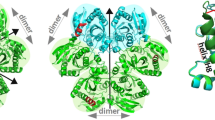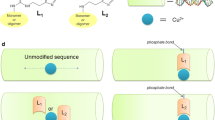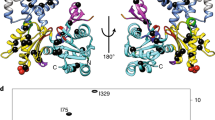Abstract
THERE have been several different approaches to the stereochemistry of the interaction of actinomycin and DNA, including studies of the interaction of DNA-like polynucleotides with actinomycin1,2, and of DNA with model compounds related to actinomycin3–5, using various experimental techniques. Reports on the optical rotatory-dispersion (ORD) and circular dichroism (CD) data for the actinomycin–DNA complex and for actinomycin alone6–9, as well as unpublished results from this laboratory, indicate that the rotational strength of the optically active transitions—which can be ascribed to the dimethylaminophenoxazone chromophore of actinomycin—in the visible region of the spectrum increases in the presence of DNA. The molecular mechanism of the interaction of actinomycin with DNA is still obscure, however, for the increase in optical activity could result from a change in the conformation of actinomycin in the presence of DNA and/or from the perturbing influence of the asymmetric environment (DNA) on the chromophore transitions of actinomycin.
This is a preview of subscription content, access via your institution
Access options
Subscribe to this journal
Receive 51 print issues and online access
$199.00 per year
only $3.90 per issue
Buy this article
- Purchase on Springer Link
- Instant access to full article PDF
Prices may be subject to local taxes which are calculated during checkout
Similar content being viewed by others
References
Reich, E., and Goldberg, I. H., in Prog. Nucleic Acid Res. Mol. Biol. (edit. by Davidson, J. N., and Cohen, W. E.), 1, 183 (Academic Press, New York, 1968).
Cerami, A., Reich, E., Ward, D. C., and Goldberg, I. H., Proc. US Nat. Acad. Sci. 57, 1036 (1967).
Ascoli, F., Savino, M., and Liquori, A. M., Nature, 217, 162 (1968).
Ascoli, F., and Savino, M., Nature, 217, 162 (1968).
Müller, W., and Crothers, D. M., J. Mol. Biol., 35, 251 (1968).
Ziffer, H., Yamaoka, K., and Mauger, A., Biochemistry, 7, 996 (1968).
Yamaoka, K., and Ziffer, H., Biochemistry, 7, 1001 (1968).
Crothers, D. M., Sabol, S. L., Ratner, D. I., and Müller, W., Biochemistry, 7, 1817 (1968).
Homer, R. B., Arch. Biochem. Biophys., 129, 405 (1969).
Moscowitz, H., in Optical Rotatory Dispersion and Circular Dichroism in Organic Chemistry (edit. by Snatzke, G.), 41 (Heyder, London, 1967).
Author information
Authors and Affiliations
Rights and permissions
About this article
Cite this article
ASCOLI, F., DE SANTIS, P. & SAVINO, M. Solvent Effect on the Conformation of Actinomycin D. Nature 227, 1237–1239 (1970). https://doi.org/10.1038/2271237a0
Received:
Revised:
Issue Date:
DOI: https://doi.org/10.1038/2271237a0
This article is cited by
-
Structure of Actinomycin based on Conformational Studies
Nature New Biology (1972)
Comments
By submitting a comment you agree to abide by our Terms and Community Guidelines. If you find something abusive or that does not comply with our terms or guidelines please flag it as inappropriate.



